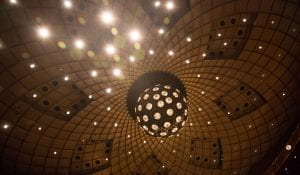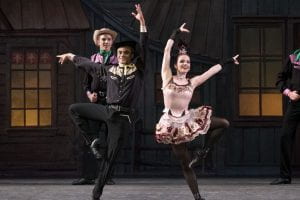
The October 2 matinee program of New York City Ballet, conducted by Andrew Litton, featured two very recent works (both having premiered September 30, 2021) by Andrea Miller and Sidra Bell. They are their first live pieces (both choreographers created ballets for New York City Ballet’s virtual New Works Festival in fall 2020)—sky to hold by Andrea Miller and SUSPENDED ANIMATION by Sidra Bell—for the company. Miller is the artistic director of the Brooklyn-based movement production company, GALLIM. A Guggenheim fellow, she’s the first choreographer to be named Artist in Residence at the Metropolitan Museum of Art and it’s easy to see why. In sky to hold, Miller offers an extraordinary fusion of collaborative dance.
The piece opens with a waft of condensed air floating across the stage, and dancers running, their multicolor costumes, with layers of fabric trailing behind them or enveloping them, are part of the spectacle. A group of seven forms into a spontaneous contact improvisation. And the dance begins.
Miller’s creative vision here includes the powerful vocals of the masterful Lido Pimienta and the costumes of blues, greens, purples, evocative of another realm, of Esteban Cortázar. In this other-worldly dominion, stand outs are Sara Mearns and Taylor Stanley, although Chun Wai Chan and Devin Alberda also impress with their big dancing. But, all in all, this is Stanley’s vehicle. I’ve been watching him throughout the season, and in this piece, his every move seems natural—contortions on the floor, even the flick of his leg—the ensemble seems to embrace him, even rescue him. His and Sara Mearns’ solos appeal on an almost visceral level. She’s fierce, her long blond hair slicked back in front, but flying, too, around her, her movement is as one possessed. Set to the dynamic score of Nicole Pearce, gentle strains alternating with thunderous strains, this deliciously unpredictable dance entertains. Miller’s choreographed lifts (random lifts in the upstage ensemble provide a startling background) and twists, angular moves, and quick changes of direction have ceremonial motifs. Everyone gets to dance in this piece, with the corps of spirits at times morphing into leads. This is a wild, exhilarating work, especially for superheroes Mearns, Stanley, Chan, and Alberda. It ends in a stop-action frieze for the dancers, a tease for the audience of what could happen next on this inventive journey of discovery.
Bell’s piece, SUSPENDED ANIMATION, too, offers many surprises, not least of which are the fanciful costumes of Christopher John Rogers. Bell’s imagination gets full play here. Other artistic outlets for Bell, besides her Sidra Bell Dance New York, is that she is also the founder and creative director of the award-winning MODULE Laboratory (a New York City-based movement and theater artist space). This is a piece with many moving parts—different composers (Nicholas Britell, Oliver Davis, Dosia McKay), the redolent lighting of Mark Stanley, the fantastic costumes, the challenging dance.
The costumes and outlandish head coverings, powder blue, chartreuse green, bright yellow, vivid orange, are a dizzying array of shapes—some billowing but cinched at the waist, or with weird tutus, reminiscent of space travel or 19th century chic, others with multiple circles around the torso, suggestive of the old yo-yo dolls, originally made of quilt circles. Rogers’ constructions are really moving sculptures. Each rendering as outrageous as the next, the dancers don’t wear these costumes, as much as emerge from them. It’s diverse, it’s inclusive. Pink dances with orange, fuchsia with lime green.
Kudos, too, to the cast of dancers Megan Fairchild, Emily Kikta, Isabella LaFreniere, Megan LeCrone, Mira Nadon, Teresa Reichlen, Harrison Ball, Christopher Grant, Kennard Henson, Anthony Huxley, KJ Takahashi, Peter Walker. They dance separately, or as an ensemble, and later in the piece, some of the more extreme features of the costumes are shed, perhaps for ease of movement, or for effect, a bid for connection. Sometimes the look is more martial arts, sometimes ballet barre. Sometimes mechanistic, sometimes ritualistic. Moving beyond the playful costumes, though, the ballet is a serious dialogue on reality, relationships, futures, or “communion,” as Bell so aptly notes.

The third piece on the program, Balanchine’s familiar Western Symphony, which premiered September 7, 1954, is a timeless favorite. With costumes by Karinska and lighting by Mark Stanley, the piece is set to Hershy Kay’s orchestrations of American folk songs such as “Red River Valley” and “Good Night Ladies”—although these hardly get noticed, so charming is the dancing set against Kay’s arranged marches and waltzes.
With its clear Western Americana themes, the lively piece demands speed and focus, delivered in the allegro by the very quick Lauren King and Ask la Cour, the adagio with Lauren Lovette and Amar Ramasar, showing so much personality, and the rondo with Emily Kikta and Andrew Veyette—notable for their playful chemistry. Remarkable, too, was the pairing of the steady Mary Elizabeth Sell of the endless pirouettes and other turns, and Lars Nelson of the amazing ballon. Nelson doesn’t overplay anything, even during his thrilling variations. Striking for its timing was all the grand battements into back attitude turns, sissonnes, tours, anything en menage, and, of course, the piece’s ending of fast, multiple pirouette, in synch, danced by the entire cast.